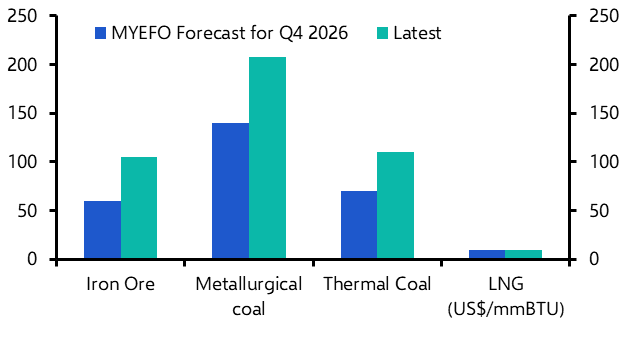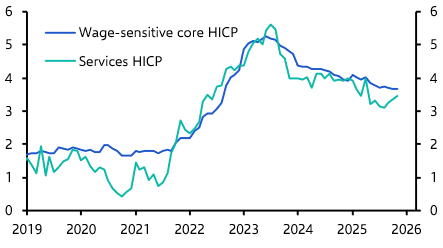All three of the world’s major economic blocs are now facing significant headwinds. In the US, these stem from an increasingly hawkish Federal Reserve, while the euro-zone faces pressure from a huge squeeze in real incomes that threatens to push the region into recession.
In China, the government’s immediate challenge has been to quash the continuing Omicron outbreak, which has resulted in tightened restrictions across some of the country’s biggest and most economically-important cities. But as we outlined in our latest China Economic Outlook, even if the authorities manage to bring the outbreak under control relatively soon, the economy still faces several challenges that will hold back its recovery.
As ever with China, doubts over the official data mean that the starting point must be to establish what’s actually happening in the real economy. We track growth using our own China Activity Proxy (CAP). It suggests that output fell outright when the first Delta wave triggered tighter restrictions in 2021, when more social distancing restrictions were imposed last summer and contracted again in March following lockdowns in Shenzhen and Jilin. (See Chart 1.)
Chart 1: Capital Economics China Activity Proxy & Official GDP (2019 = 100, seas. adj.)
 Sources: CEIC, WIND, Capital Economics
Sources: CEIC, WIND, Capital Economics
The Omicron variant is the biggest wave of COVID-19 that China has faced, having spread in areas that generate 40% of China’s GDP and ship 80% of its exports. (See Chart 2.) Whatever the official GDP figures say, we think that China’s economy is likely to expand by only 2% this year.
Chart 2: China Activity in Areas with Local Outbreaks (%)
 Sources: CEIC, Capital Economics
Sources: CEIC, Capital Economics
There is of course a great deal of uncertainty over what happens next. Restrictions are being tightened in Beijing and there’s widespread speculation about whether the capital will be forced into a Shanghai-style lockdown. We think there’s a good chance that officials there won’t repeat the mistakes that allowed infections to get out of control in Shanghai and that they will succeed in isolating virus clusters much more quickly. Understandably, a lot of global attention has been paid to the failure of China’s zero-COVID approach in Shanghai, but we shouldn’t forget the successes in quashing outbreaks in Shenzhen and Tianjin a few weeks before. If the current outbreak is also quashed, there is likely to be a healthy rebound in consumer services activity.
But China’s broader economic backdrop will remain challenging. In 2020, its initial post-lockdown recovery was aided by a surge in construction activity. Now, property developers are struggling to finance ongoing projects. They won’t launch new ones until there has been a marked pick-up in sales.
China has also benefited over the past couple of years from the strength of global demand for consumer goods. But this demand now seems to be fading as consumption habits in advanced economies return to pre-COVID norms – Amazon’s Q1 earnings reflected this shift – and spending on services rebounds. China’s goods exports are more likely to fall than rise further over the rest of this year.
Policy easing will offer less of a tailwind this time too. Officials appear wary about the costs of another round of large-scale fiscal stimulus, with aggregate government debt by our count now approaching 100% of GDP. There is also growing awareness of the risks to financial stability posed by another large expansion of credit.
The result of all of this is that China’s recovery is likely to be underwhelming and its economic performance weaker over the next couple of years than most anticipate. While the recent focus has understandably been on the immediate fallout from the latest COVID outbreak, the challenges facing economic policymakers in Beijing extend well beyond the next few quarters. A common theme in the constraints to any post-Omicron recovery is that they signal the extent to which the past drivers of China’s growth no longer work.
The 25-year property boom has run out of steam as urbanisation has slowed to a crawl and the population of young homebuyers has gone into decline. Exports lifted China to becoming the world’s major goods exporter but, outside the extraordinary circumstances of a pandemic, they can’t lift it any higher. Credit-fuelled investment has given China world-beating infrastructure, but increasingly is contributing to financial overhangs that threaten the stability of its banking sector.
We have talked for a long time about the long-term challenges facing China, but these are now becoming more immediate. The headwinds facing the economy are not just likely to slow growth this year: they are reasons to think that China’s growth will remain weak for years to come.
In case you missed it
- Our Q2 Global Economic and Markets Outlooks explore how economic growth and financial markets will perform in a world of high inflation and hawkish central bankers.
- The suspension of gas exports to Poland and Bulgaria is crystallising economic risks around Russian supply to the rest of Europe.
- As the Reserve Bank of Australia begins what we expect to be an aggressive rate hike cycle, track the country’s inflation dynamics and our forecasts on our interactive dashboard on CEI.



